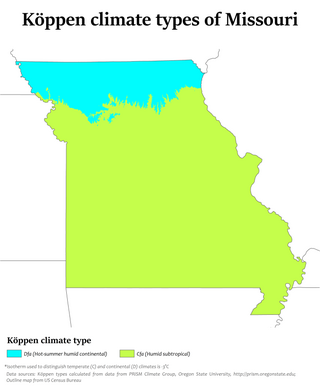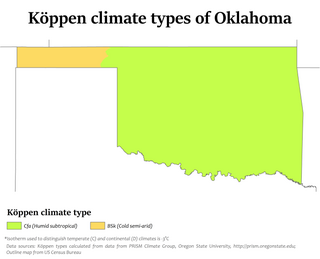The effects of climate change in Saskatchewan are now being observed in parts of the province. There is evidence of reduction of biomass in Saskatchewan's boreal forests that is linked by researchers to drought-related water stress stemming from global warming, most likely caused by greenhouse gas emissions. While studies, as early as 1988 have shown that climate change will affect agriculture, whether the effects can be mitigated through adaptations of cultivars, or crops, is less clear. Resiliency of ecosystems may decline with large changes in temperature. The provincial government has responded to the threat of climate change by introducing a plan to reduce carbon emissions, "The Saskatchewan Energy and Climate Change Plan", in June 2007.

Climate change in Alabama encompasses the effects of climate change, attributed to man-made increases in atmospheric carbon dioxide, in the U.S. state of Alabama.

Climate change in Arkansas refers to the effects of climate change attributed to man-made increases in atmospheric carbon dioxide in the state of Arkansas.

Climate change in Colorado encompasses the effects of climate change, attributed to man-made increases in atmospheric carbon dioxide, in the U.S. state of Colorado.

Climate change in Delaware encompasses the effects of climate change, attributed to man-made increases in atmospheric carbon dioxide, in the U.S. state of Delaware.

Climate change in Georgia encompasses the effects of climate change, attributed to man-made increases in atmospheric carbon dioxide, in the U.S. state of Georgia.

Climate change in Indiana encompasses the effects of climate change, attributed to man-made increases in atmospheric carbon dioxide, in the U.S. state of Indiana.

Climate change in Kentucky encompasses the effects of climate change, attributed to man-made increases in atmospheric carbon dioxide, in the U.S. state of Kentucky.

Climate change in Louisiana encompasses the effects of climate change, attributed to man-made increases in atmospheric carbon dioxide, in the U.S. state of Louisiana.

Climate change in Minnesota encompasses the effects of climate change, attributed to human-caused increases in atmospheric carbon dioxide, in the U.S. state of Minnesota.

Climate change in Mississippi encompasses the effects of climate change, attributed to man-made increases in atmospheric carbon dioxide, in the U.S. state of Mississippi.

Climate change in Missouri encompasses the effects of climate change, attributed to man-made increases in atmospheric carbon dioxide, in the U.S. state of Missouri.

Climate change in North Dakota encompasses the effects of climate change, attributed to man-made increases in atmospheric carbon dioxide, in the U.S. state of North Dakota.

Climate change in Oklahoma encompasses the effects of climate change, attributed to man-made increases in atmospheric carbon dioxide, in the U.S. state of Oklahoma.

Climate change in the United States Virgin Islands encompasses the effects of climate change, attributed to man-made increases in atmospheric carbon dioxide, in the U.S. territory of the United States Virgin Islands. The United States Environmental Protection Agency (EPA) has noted a variety of expected consequences of this phenomenon.

Climate change in Utah encompasses the effects of climate change, attributed to man-made increases in atmospheric carbon dioxide, in the U.S. state of Utah.

Climate change in Vermont encompasses the effects of climate change, attributed to man-made increases in atmospheric carbon dioxide, in the U.S. state of Vermont.

Climate change in New York encompasses the effects of climate change, attributed to man-made increases in atmospheric greenhouse gases, in the U.S. state of New York. It is of concern due to its impact on the people, ecosystem, and economy of the state. Many parts of the state are already experiencing weather changes, and sea-level rise, and threatening local communities.

Climate change in South Dakota encompasses the effects of climate change, attributed to man-made increases in atmospheric carbon dioxide, in the U.S. state of South Dakota.

Climate change in Pennsylvania encompasses the effects of climate change, attributed to man-made increases in atmospheric carbon dioxide, in the U.S. state of Pennsylvania.































